QSO 300 Final Project: Nissan's Business Operations Analysis
VerifiedAdded on 2022/09/28
|18
|3905
|18
Case Study
AI Summary
This case study analyzes Nissan's response to the 2011 earthquake and tsunami, focusing on how the company leveraged operations management (OM) practices to mitigate the disaster's impact. The analysis examines Nissan's value generation through OM functions, including global emergency centers and supply chain management. It contrasts service and manufacturing operations and explores theories and techniques such as CPM, PERT, and priority rules for job sequencing. The study delves into the theory of constraints, forecasting systems, and chain risks. Furthermore, it provides in-depth descriptions of JIT, TPS, and Lean methodologies. The assignment highlights how Nissan's operational strategies, including its global manufacturing network and disaster preparedness, enabled it to maintain production and minimize disruptions, offering insights into business resilience and operational efficiency in crisis situations. The case study underscores Nissan's ability to adapt and maintain customer service despite facing significant challenges.
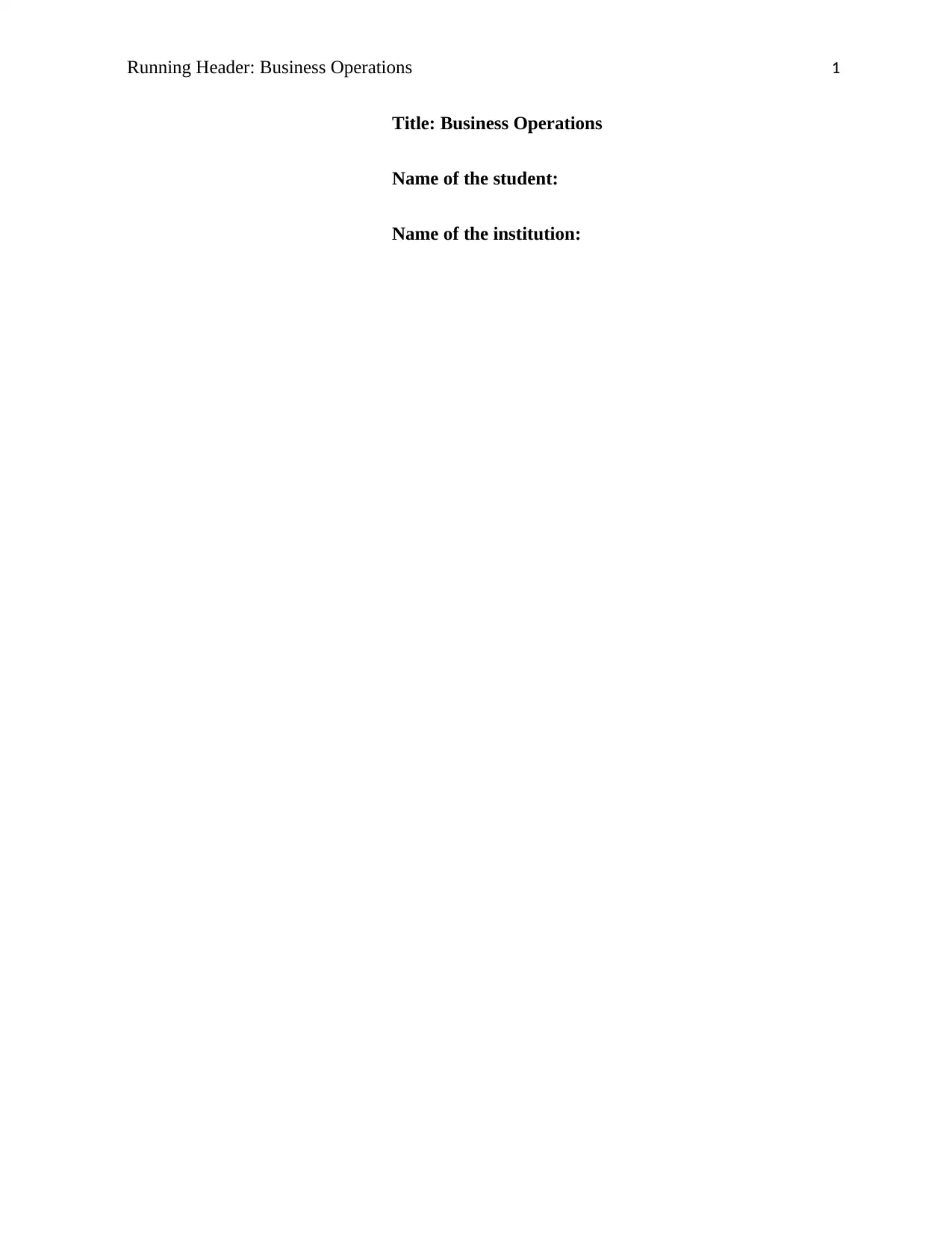
Running Header: Business Operations 1
Title: Business Operations
Name of the student:
Name of the institution:
Title: Business Operations
Name of the student:
Name of the institution:
Paraphrase This Document
Need a fresh take? Get an instant paraphrase of this document with our AI Paraphraser
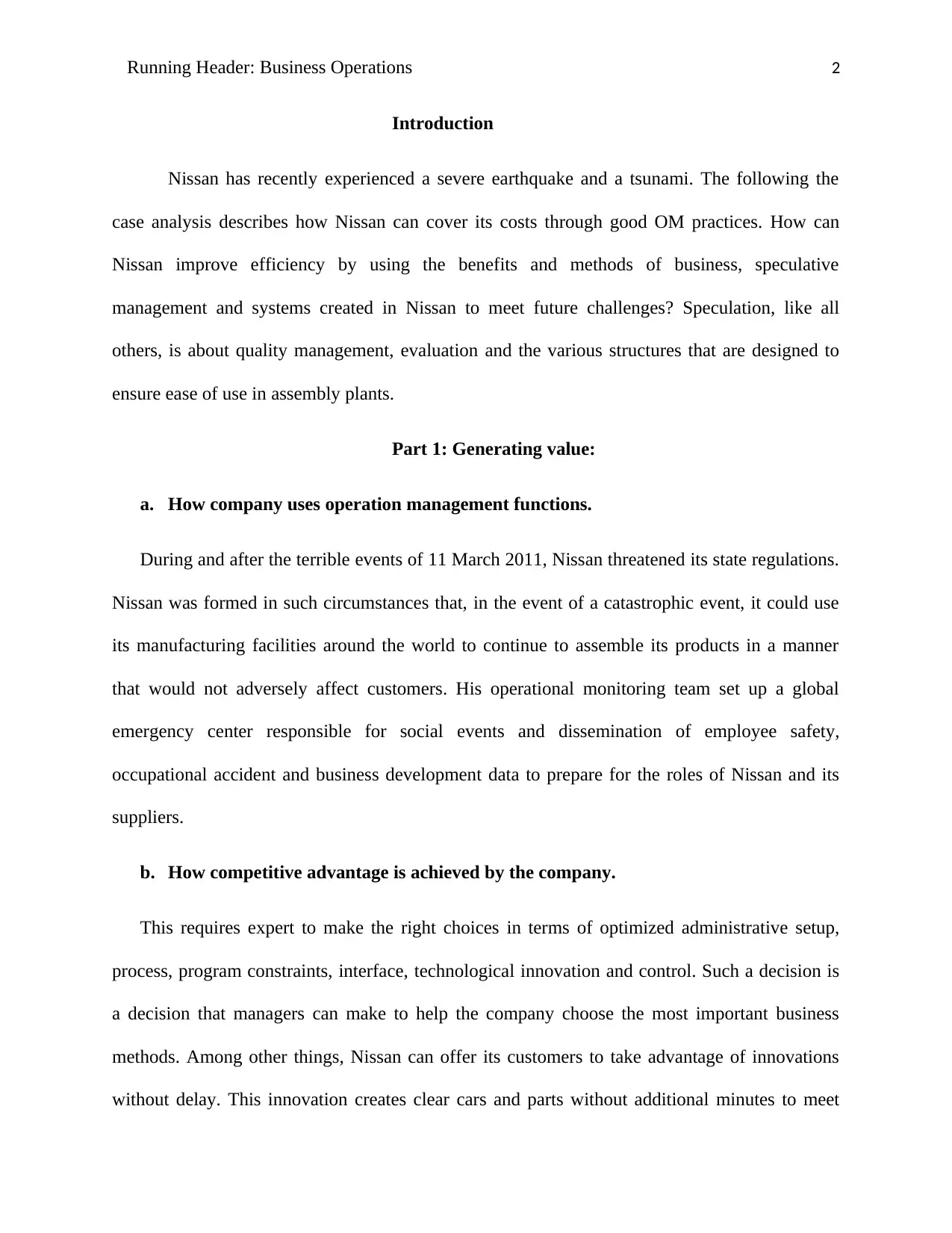
Running Header: Business Operations 2
Introduction
Nissan has recently experienced a severe earthquake and a tsunami. The following the
case analysis describes how Nissan can cover its costs through good OM practices. How can
Nissan improve efficiency by using the benefits and methods of business, speculative
management and systems created in Nissan to meet future challenges? Speculation, like all
others, is about quality management, evaluation and the various structures that are designed to
ensure ease of use in assembly plants.
Part 1: Generating value:
a. How company uses operation management functions.
During and after the terrible events of 11 March 2011, Nissan threatened its state regulations.
Nissan was formed in such circumstances that, in the event of a catastrophic event, it could use
its manufacturing facilities around the world to continue to assemble its products in a manner
that would not adversely affect customers. His operational monitoring team set up a global
emergency center responsible for social events and dissemination of employee safety,
occupational accident and business development data to prepare for the roles of Nissan and its
suppliers.
b. How competitive advantage is achieved by the company.
This requires expert to make the right choices in terms of optimized administrative setup,
process, program constraints, interface, technological innovation and control. Such a decision is
a decision that managers can make to help the company choose the most important business
methods. Among other things, Nissan can offer its customers to take advantage of innovations
without delay. This innovation creates clear cars and parts without additional minutes to meet
Introduction
Nissan has recently experienced a severe earthquake and a tsunami. The following the
case analysis describes how Nissan can cover its costs through good OM practices. How can
Nissan improve efficiency by using the benefits and methods of business, speculative
management and systems created in Nissan to meet future challenges? Speculation, like all
others, is about quality management, evaluation and the various structures that are designed to
ensure ease of use in assembly plants.
Part 1: Generating value:
a. How company uses operation management functions.
During and after the terrible events of 11 March 2011, Nissan threatened its state regulations.
Nissan was formed in such circumstances that, in the event of a catastrophic event, it could use
its manufacturing facilities around the world to continue to assemble its products in a manner
that would not adversely affect customers. His operational monitoring team set up a global
emergency center responsible for social events and dissemination of employee safety,
occupational accident and business development data to prepare for the roles of Nissan and its
suppliers.
b. How competitive advantage is achieved by the company.
This requires expert to make the right choices in terms of optimized administrative setup,
process, program constraints, interface, technological innovation and control. Such a decision is
a decision that managers can make to help the company choose the most important business
methods. Among other things, Nissan can offer its customers to take advantage of innovations
without delay. This innovation creates clear cars and parts without additional minutes to meet
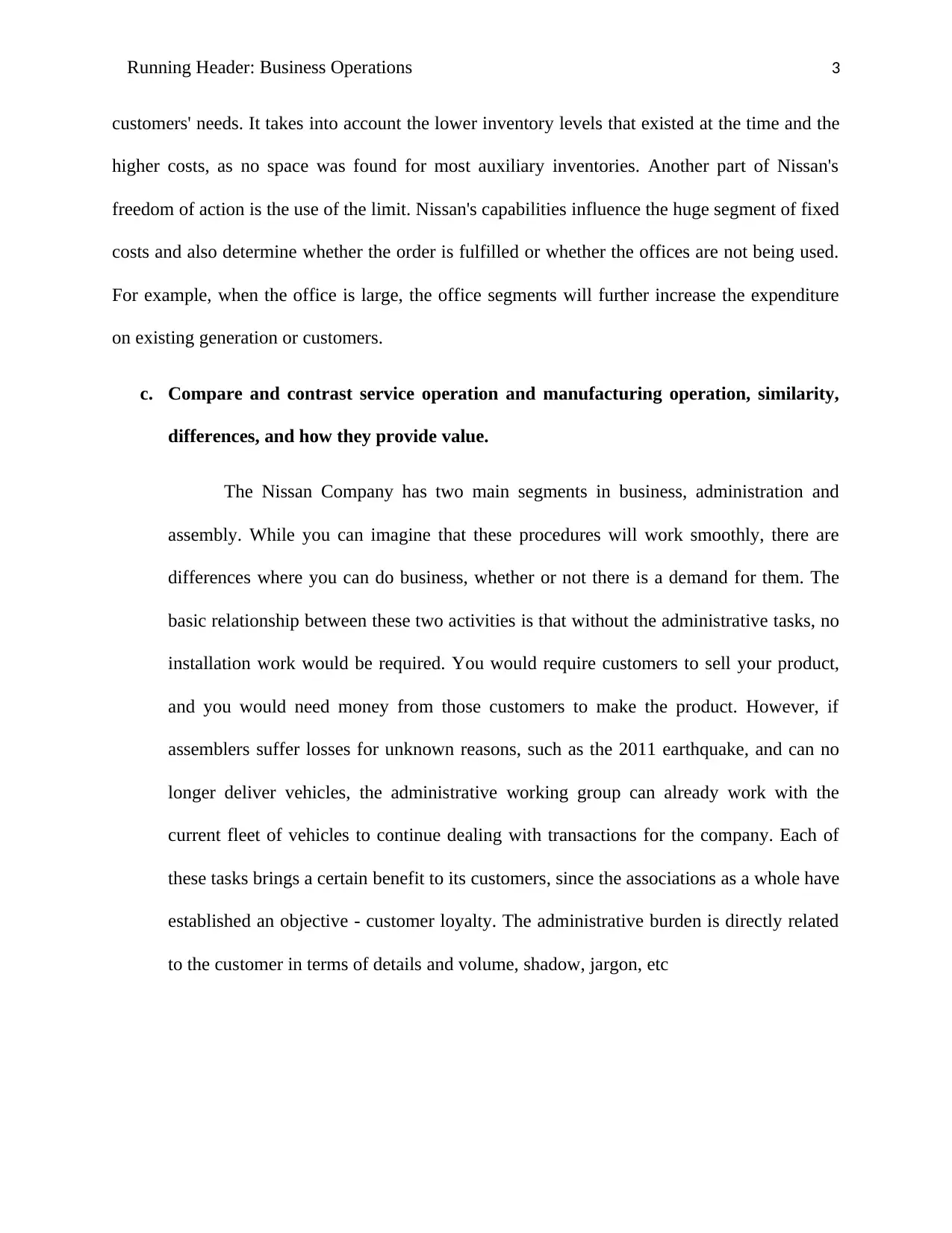
Running Header: Business Operations 3
customers' needs. It takes into account the lower inventory levels that existed at the time and the
higher costs, as no space was found for most auxiliary inventories. Another part of Nissan's
freedom of action is the use of the limit. Nissan's capabilities influence the huge segment of fixed
costs and also determine whether the order is fulfilled or whether the offices are not being used.
For example, when the office is large, the office segments will further increase the expenditure
on existing generation or customers.
c. Compare and contrast service operation and manufacturing operation, similarity,
differences, and how they provide value.
The Nissan Company has two main segments in business, administration and
assembly. While you can imagine that these procedures will work smoothly, there are
differences where you can do business, whether or not there is a demand for them. The
basic relationship between these two activities is that without the administrative tasks, no
installation work would be required. You would require customers to sell your product,
and you would need money from those customers to make the product. However, if
assemblers suffer losses for unknown reasons, such as the 2011 earthquake, and can no
longer deliver vehicles, the administrative working group can already work with the
current fleet of vehicles to continue dealing with transactions for the company. Each of
these tasks brings a certain benefit to its customers, since the associations as a whole have
established an objective - customer loyalty. The administrative burden is directly related
to the customer in terms of details and volume, shadow, jargon, etc
customers' needs. It takes into account the lower inventory levels that existed at the time and the
higher costs, as no space was found for most auxiliary inventories. Another part of Nissan's
freedom of action is the use of the limit. Nissan's capabilities influence the huge segment of fixed
costs and also determine whether the order is fulfilled or whether the offices are not being used.
For example, when the office is large, the office segments will further increase the expenditure
on existing generation or customers.
c. Compare and contrast service operation and manufacturing operation, similarity,
differences, and how they provide value.
The Nissan Company has two main segments in business, administration and
assembly. While you can imagine that these procedures will work smoothly, there are
differences where you can do business, whether or not there is a demand for them. The
basic relationship between these two activities is that without the administrative tasks, no
installation work would be required. You would require customers to sell your product,
and you would need money from those customers to make the product. However, if
assemblers suffer losses for unknown reasons, such as the 2011 earthquake, and can no
longer deliver vehicles, the administrative working group can already work with the
current fleet of vehicles to continue dealing with transactions for the company. Each of
these tasks brings a certain benefit to its customers, since the associations as a whole have
established an objective - customer loyalty. The administrative burden is directly related
to the customer in terms of details and volume, shadow, jargon, etc
⊘ This is a preview!⊘
Do you want full access?
Subscribe today to unlock all pages.

Trusted by 1+ million students worldwide
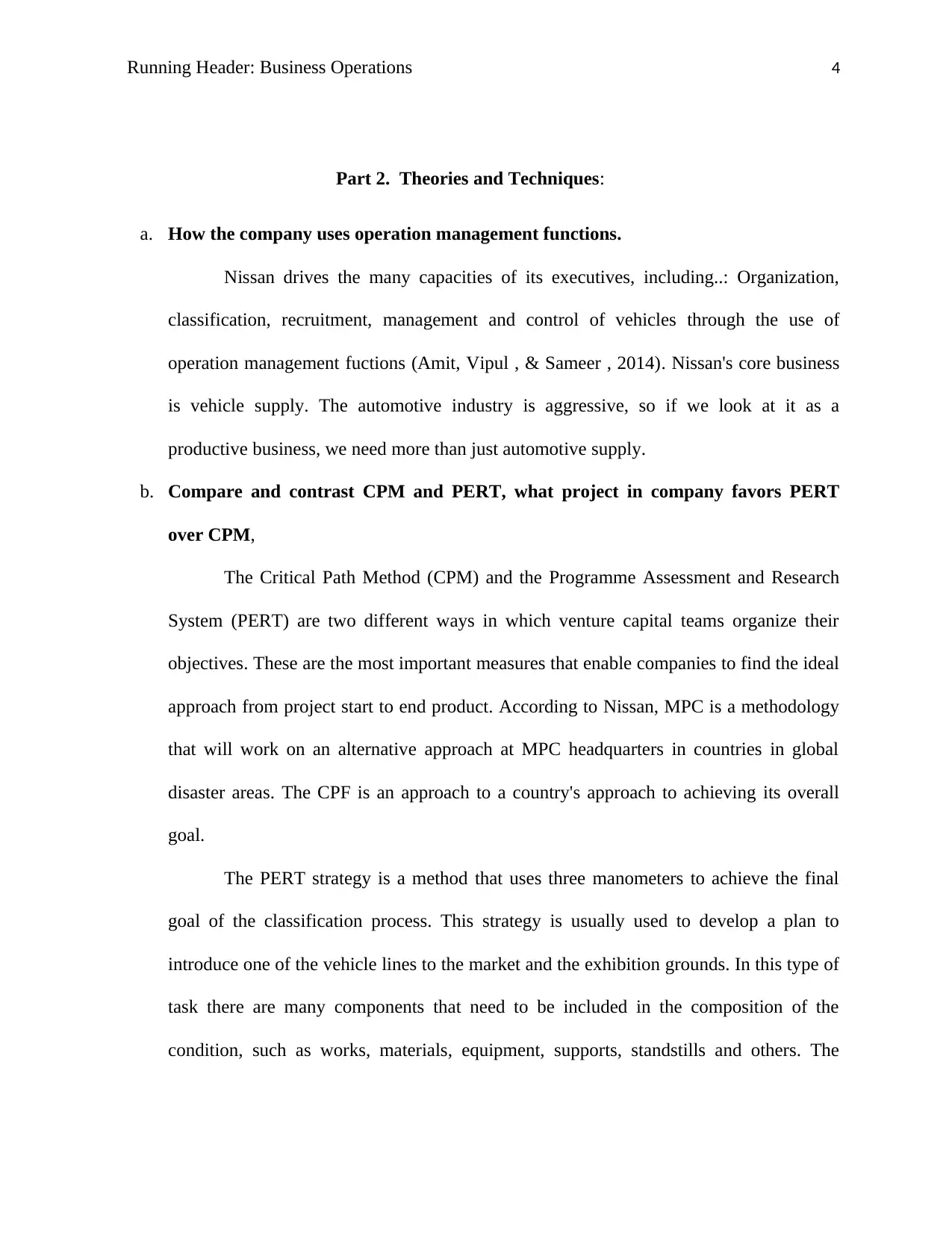
Running Header: Business Operations 4
Part 2. Theories and Techniques:
a. How the company uses operation management functions.
Nissan drives the many capacities of its executives, including..: Organization,
classification, recruitment, management and control of vehicles through the use of
operation management fuctions (Amit, Vipul , & Sameer , 2014). Nissan's core business
is vehicle supply. The automotive industry is aggressive, so if we look at it as a
productive business, we need more than just automotive supply.
b. Compare and contrast CPM and PERT, what project in company favors PERT
over CPM,
The Critical Path Method (CPM) and the Programme Assessment and Research
System (PERT) are two different ways in which venture capital teams organize their
objectives. These are the most important measures that enable companies to find the ideal
approach from project start to end product. According to Nissan, MPC is a methodology
that will work on an alternative approach at MPC headquarters in countries in global
disaster areas. The CPF is an approach to a country's approach to achieving its overall
goal.
The PERT strategy is a method that uses three manometers to achieve the final
goal of the classification process. This strategy is usually used to develop a plan to
introduce one of the vehicle lines to the market and the exhibition grounds. In this type of
task there are many components that need to be included in the composition of the
condition, such as works, materials, equipment, supports, standstills and others. The
Part 2. Theories and Techniques:
a. How the company uses operation management functions.
Nissan drives the many capacities of its executives, including..: Organization,
classification, recruitment, management and control of vehicles through the use of
operation management fuctions (Amit, Vipul , & Sameer , 2014). Nissan's core business
is vehicle supply. The automotive industry is aggressive, so if we look at it as a
productive business, we need more than just automotive supply.
b. Compare and contrast CPM and PERT, what project in company favors PERT
over CPM,
The Critical Path Method (CPM) and the Programme Assessment and Research
System (PERT) are two different ways in which venture capital teams organize their
objectives. These are the most important measures that enable companies to find the ideal
approach from project start to end product. According to Nissan, MPC is a methodology
that will work on an alternative approach at MPC headquarters in countries in global
disaster areas. The CPF is an approach to a country's approach to achieving its overall
goal.
The PERT strategy is a method that uses three manometers to achieve the final
goal of the classification process. This strategy is usually used to develop a plan to
introduce one of the vehicle lines to the market and the exhibition grounds. In this type of
task there are many components that need to be included in the composition of the
condition, such as works, materials, equipment, supports, standstills and others. The
Paraphrase This Document
Need a fresh take? Get an instant paraphrase of this document with our AI Paraphraser
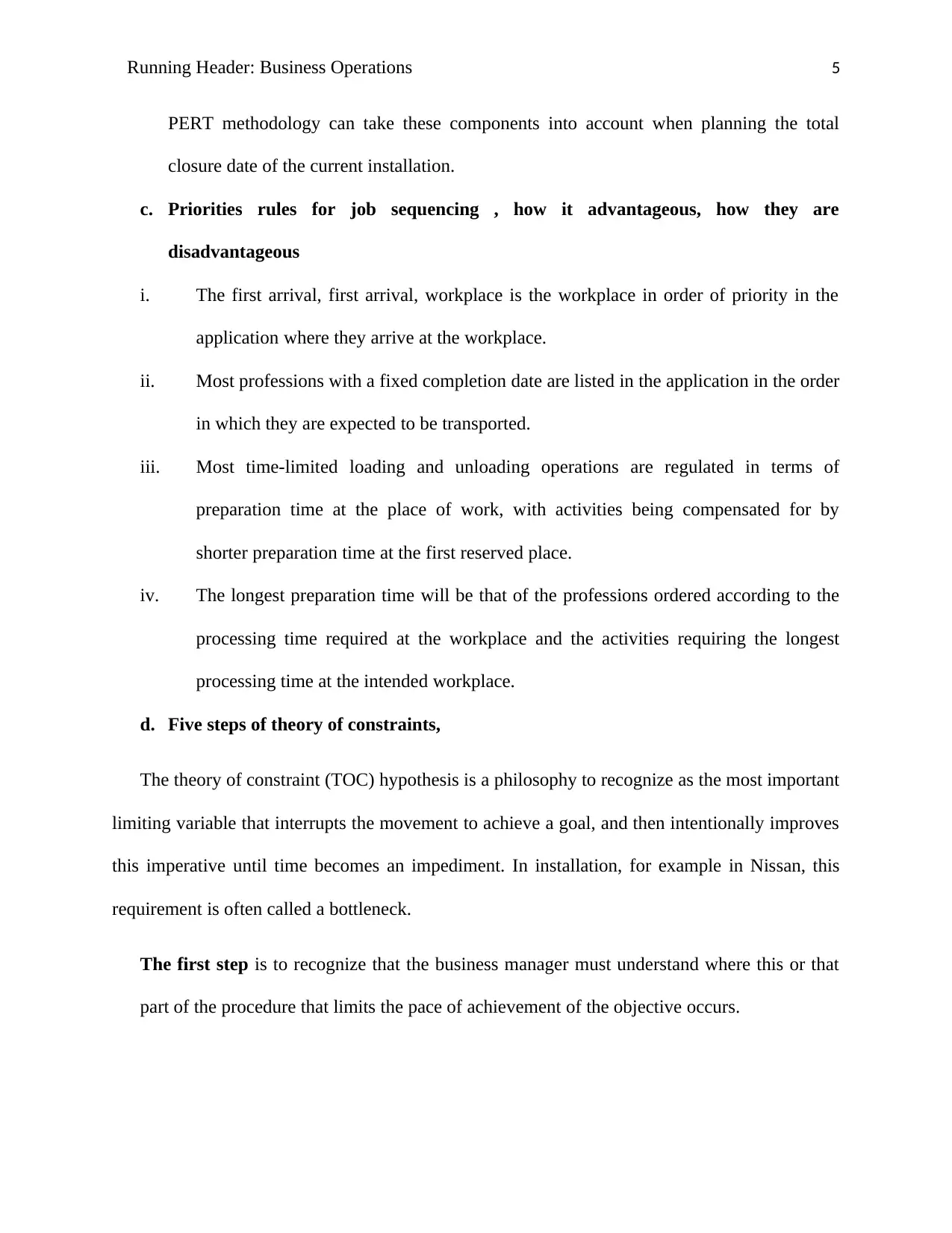
Running Header: Business Operations 5
PERT methodology can take these components into account when planning the total
closure date of the current installation.
c. Priorities rules for job sequencing , how it advantageous, how they are
disadvantageous
i. The first arrival, first arrival, workplace is the workplace in order of priority in the
application where they arrive at the workplace.
ii. Most professions with a fixed completion date are listed in the application in the order
in which they are expected to be transported.
iii. Most time-limited loading and unloading operations are regulated in terms of
preparation time at the place of work, with activities being compensated for by
shorter preparation time at the first reserved place.
iv. The longest preparation time will be that of the professions ordered according to the
processing time required at the workplace and the activities requiring the longest
processing time at the intended workplace.
d. Five steps of theory of constraints,
The theory of constraint (TOC) hypothesis is a philosophy to recognize as the most important
limiting variable that interrupts the movement to achieve a goal, and then intentionally improves
this imperative until time becomes an impediment. In installation, for example in Nissan, this
requirement is often called a bottleneck.
The first step is to recognize that the business manager must understand where this or that
part of the procedure that limits the pace of achievement of the objective occurs.
PERT methodology can take these components into account when planning the total
closure date of the current installation.
c. Priorities rules for job sequencing , how it advantageous, how they are
disadvantageous
i. The first arrival, first arrival, workplace is the workplace in order of priority in the
application where they arrive at the workplace.
ii. Most professions with a fixed completion date are listed in the application in the order
in which they are expected to be transported.
iii. Most time-limited loading and unloading operations are regulated in terms of
preparation time at the place of work, with activities being compensated for by
shorter preparation time at the first reserved place.
iv. The longest preparation time will be that of the professions ordered according to the
processing time required at the workplace and the activities requiring the longest
processing time at the intended workplace.
d. Five steps of theory of constraints,
The theory of constraint (TOC) hypothesis is a philosophy to recognize as the most important
limiting variable that interrupts the movement to achieve a goal, and then intentionally improves
this imperative until time becomes an impediment. In installation, for example in Nissan, this
requirement is often called a bottleneck.
The first step is to recognize that the business manager must understand where this or that
part of the procedure that limits the pace of achievement of the objective occurs.
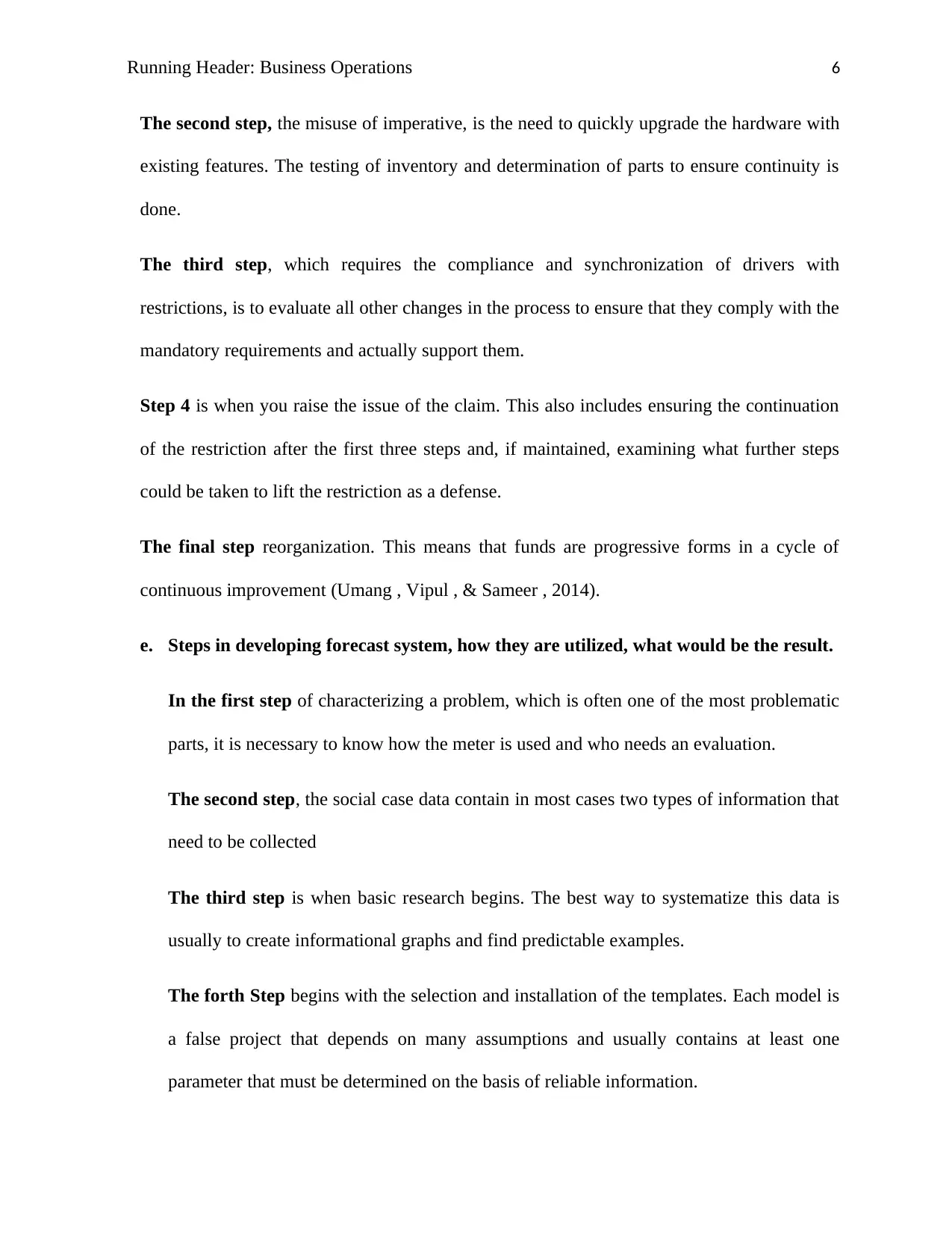
Running Header: Business Operations 6
The second step, the misuse of imperative, is the need to quickly upgrade the hardware with
existing features. The testing of inventory and determination of parts to ensure continuity is
done.
The third step, which requires the compliance and synchronization of drivers with
restrictions, is to evaluate all other changes in the process to ensure that they comply with the
mandatory requirements and actually support them.
Step 4 is when you raise the issue of the claim. This also includes ensuring the continuation
of the restriction after the first three steps and, if maintained, examining what further steps
could be taken to lift the restriction as a defense.
The final step reorganization. This means that funds are progressive forms in a cycle of
continuous improvement (Umang , Vipul , & Sameer , 2014).
e. Steps in developing forecast system, how they are utilized, what would be the result.
In the first step of characterizing a problem, which is often one of the most problematic
parts, it is necessary to know how the meter is used and who needs an evaluation.
The second step, the social case data contain in most cases two types of information that
need to be collected
The third step is when basic research begins. The best way to systematize this data is
usually to create informational graphs and find predictable examples.
The forth Step begins with the selection and installation of the templates. Each model is
a false project that depends on many assumptions and usually contains at least one
parameter that must be determined on the basis of reliable information.
The second step, the misuse of imperative, is the need to quickly upgrade the hardware with
existing features. The testing of inventory and determination of parts to ensure continuity is
done.
The third step, which requires the compliance and synchronization of drivers with
restrictions, is to evaluate all other changes in the process to ensure that they comply with the
mandatory requirements and actually support them.
Step 4 is when you raise the issue of the claim. This also includes ensuring the continuation
of the restriction after the first three steps and, if maintained, examining what further steps
could be taken to lift the restriction as a defense.
The final step reorganization. This means that funds are progressive forms in a cycle of
continuous improvement (Umang , Vipul , & Sameer , 2014).
e. Steps in developing forecast system, how they are utilized, what would be the result.
In the first step of characterizing a problem, which is often one of the most problematic
parts, it is necessary to know how the meter is used and who needs an evaluation.
The second step, the social case data contain in most cases two types of information that
need to be collected
The third step is when basic research begins. The best way to systematize this data is
usually to create informational graphs and find predictable examples.
The forth Step begins with the selection and installation of the templates. Each model is
a false project that depends on many assumptions and usually contains at least one
parameter that must be determined on the basis of reliable information.
⊘ This is a preview!⊘
Do you want full access?
Subscribe today to unlock all pages.

Trusted by 1+ million students worldwide
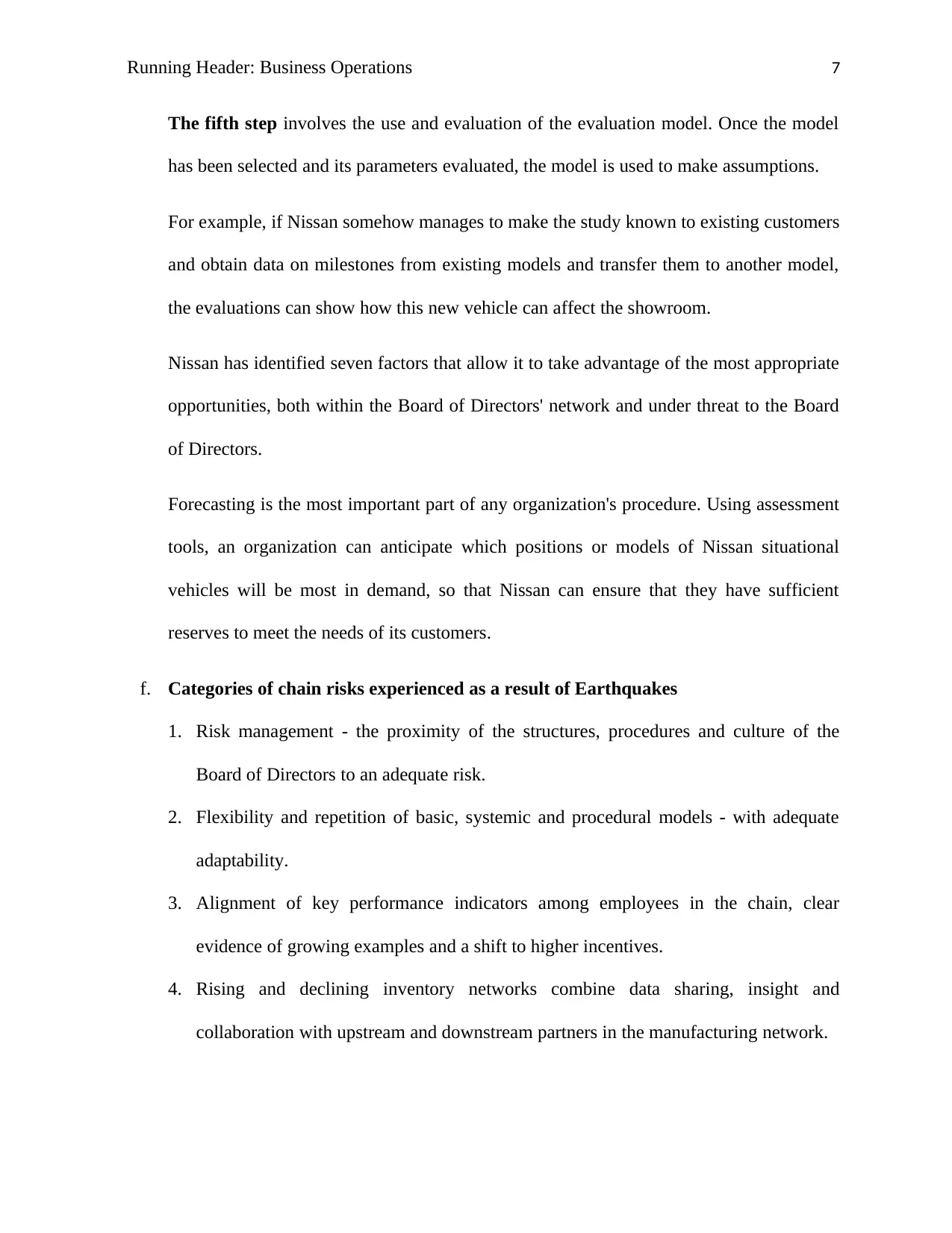
Running Header: Business Operations 7
The fifth step involves the use and evaluation of the evaluation model. Once the model
has been selected and its parameters evaluated, the model is used to make assumptions.
For example, if Nissan somehow manages to make the study known to existing customers
and obtain data on milestones from existing models and transfer them to another model,
the evaluations can show how this new vehicle can affect the showroom.
Nissan has identified seven factors that allow it to take advantage of the most appropriate
opportunities, both within the Board of Directors' network and under threat to the Board
of Directors.
Forecasting is the most important part of any organization's procedure. Using assessment
tools, an organization can anticipate which positions or models of Nissan situational
vehicles will be most in demand, so that Nissan can ensure that they have sufficient
reserves to meet the needs of its customers.
f. Categories of chain risks experienced as a result of Earthquakes
1. Risk management - the proximity of the structures, procedures and culture of the
Board of Directors to an adequate risk.
2. Flexibility and repetition of basic, systemic and procedural models - with adequate
adaptability.
3. Alignment of key performance indicators among employees in the chain, clear
evidence of growing examples and a shift to higher incentives.
4. Rising and declining inventory networks combine data sharing, insight and
collaboration with upstream and downstream partners in the manufacturing network.
The fifth step involves the use and evaluation of the evaluation model. Once the model
has been selected and its parameters evaluated, the model is used to make assumptions.
For example, if Nissan somehow manages to make the study known to existing customers
and obtain data on milestones from existing models and transfer them to another model,
the evaluations can show how this new vehicle can affect the showroom.
Nissan has identified seven factors that allow it to take advantage of the most appropriate
opportunities, both within the Board of Directors' network and under threat to the Board
of Directors.
Forecasting is the most important part of any organization's procedure. Using assessment
tools, an organization can anticipate which positions or models of Nissan situational
vehicles will be most in demand, so that Nissan can ensure that they have sufficient
reserves to meet the needs of its customers.
f. Categories of chain risks experienced as a result of Earthquakes
1. Risk management - the proximity of the structures, procedures and culture of the
Board of Directors to an adequate risk.
2. Flexibility and repetition of basic, systemic and procedural models - with adequate
adaptability.
3. Alignment of key performance indicators among employees in the chain, clear
evidence of growing examples and a shift to higher incentives.
4. Rising and declining inventory networks combine data sharing, insight and
collaboration with upstream and downstream partners in the manufacturing network.
Paraphrase This Document
Need a fresh take? Get an instant paraphrase of this document with our AI Paraphraser
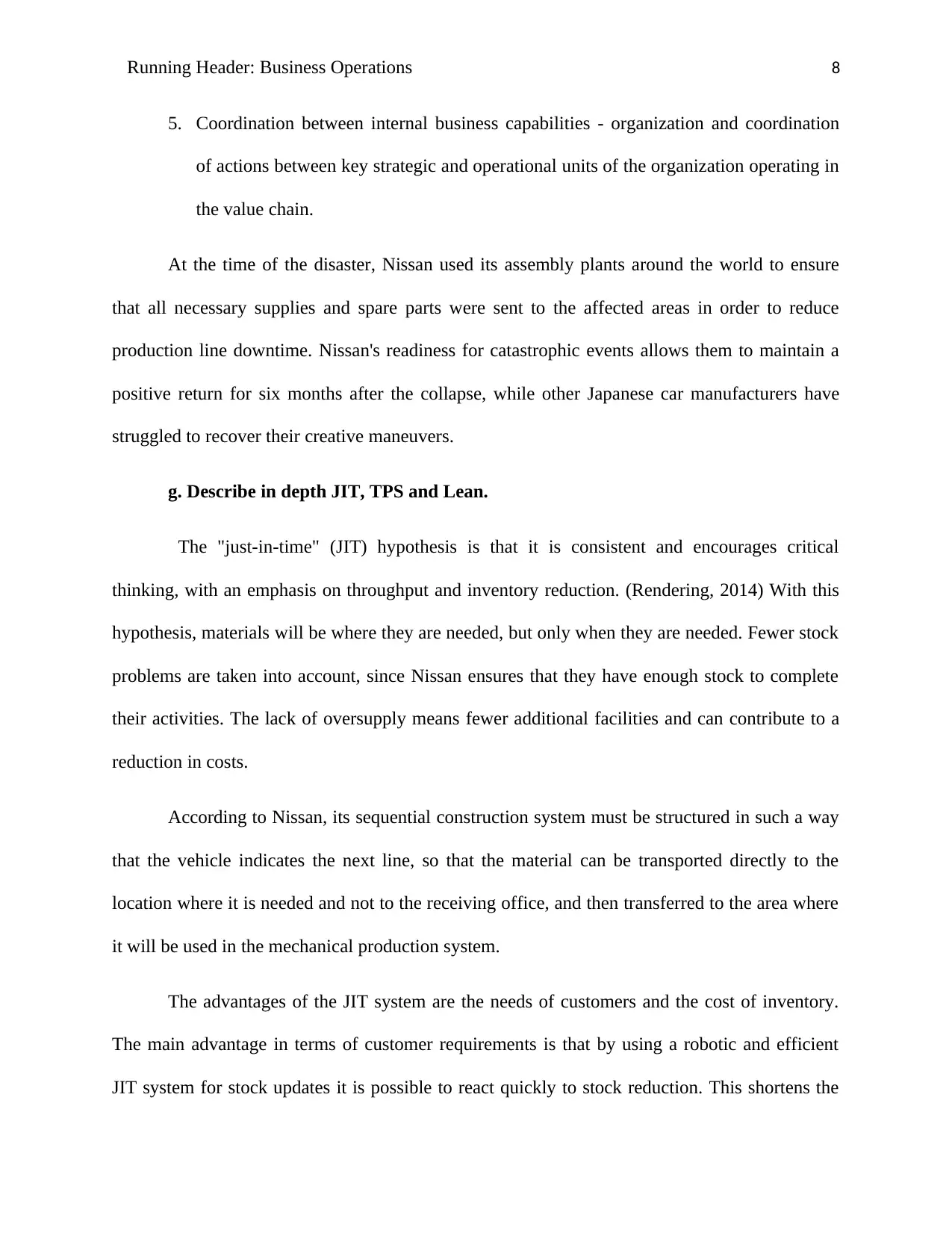
Running Header: Business Operations 8
5. Coordination between internal business capabilities - organization and coordination
of actions between key strategic and operational units of the organization operating in
the value chain.
At the time of the disaster, Nissan used its assembly plants around the world to ensure
that all necessary supplies and spare parts were sent to the affected areas in order to reduce
production line downtime. Nissan's readiness for catastrophic events allows them to maintain a
positive return for six months after the collapse, while other Japanese car manufacturers have
struggled to recover their creative maneuvers.
g. Describe in depth JIT, TPS and Lean.
The "just-in-time" (JIT) hypothesis is that it is consistent and encourages critical
thinking, with an emphasis on throughput and inventory reduction. (Rendering, 2014) With this
hypothesis, materials will be where they are needed, but only when they are needed. Fewer stock
problems are taken into account, since Nissan ensures that they have enough stock to complete
their activities. The lack of oversupply means fewer additional facilities and can contribute to a
reduction in costs.
According to Nissan, its sequential construction system must be structured in such a way
that the vehicle indicates the next line, so that the material can be transported directly to the
location where it is needed and not to the receiving office, and then transferred to the area where
it will be used in the mechanical production system.
The advantages of the JIT system are the needs of customers and the cost of inventory.
The main advantage in terms of customer requirements is that by using a robotic and efficient
JIT system for stock updates it is possible to react quickly to stock reduction. This shortens the
5. Coordination between internal business capabilities - organization and coordination
of actions between key strategic and operational units of the organization operating in
the value chain.
At the time of the disaster, Nissan used its assembly plants around the world to ensure
that all necessary supplies and spare parts were sent to the affected areas in order to reduce
production line downtime. Nissan's readiness for catastrophic events allows them to maintain a
positive return for six months after the collapse, while other Japanese car manufacturers have
struggled to recover their creative maneuvers.
g. Describe in depth JIT, TPS and Lean.
The "just-in-time" (JIT) hypothesis is that it is consistent and encourages critical
thinking, with an emphasis on throughput and inventory reduction. (Rendering, 2014) With this
hypothesis, materials will be where they are needed, but only when they are needed. Fewer stock
problems are taken into account, since Nissan ensures that they have enough stock to complete
their activities. The lack of oversupply means fewer additional facilities and can contribute to a
reduction in costs.
According to Nissan, its sequential construction system must be structured in such a way
that the vehicle indicates the next line, so that the material can be transported directly to the
location where it is needed and not to the receiving office, and then transferred to the area where
it will be used in the mechanical production system.
The advantages of the JIT system are the needs of customers and the cost of inventory.
The main advantage in terms of customer requirements is that by using a robotic and efficient
JIT system for stock updates it is possible to react quickly to stock reduction. This shortens the
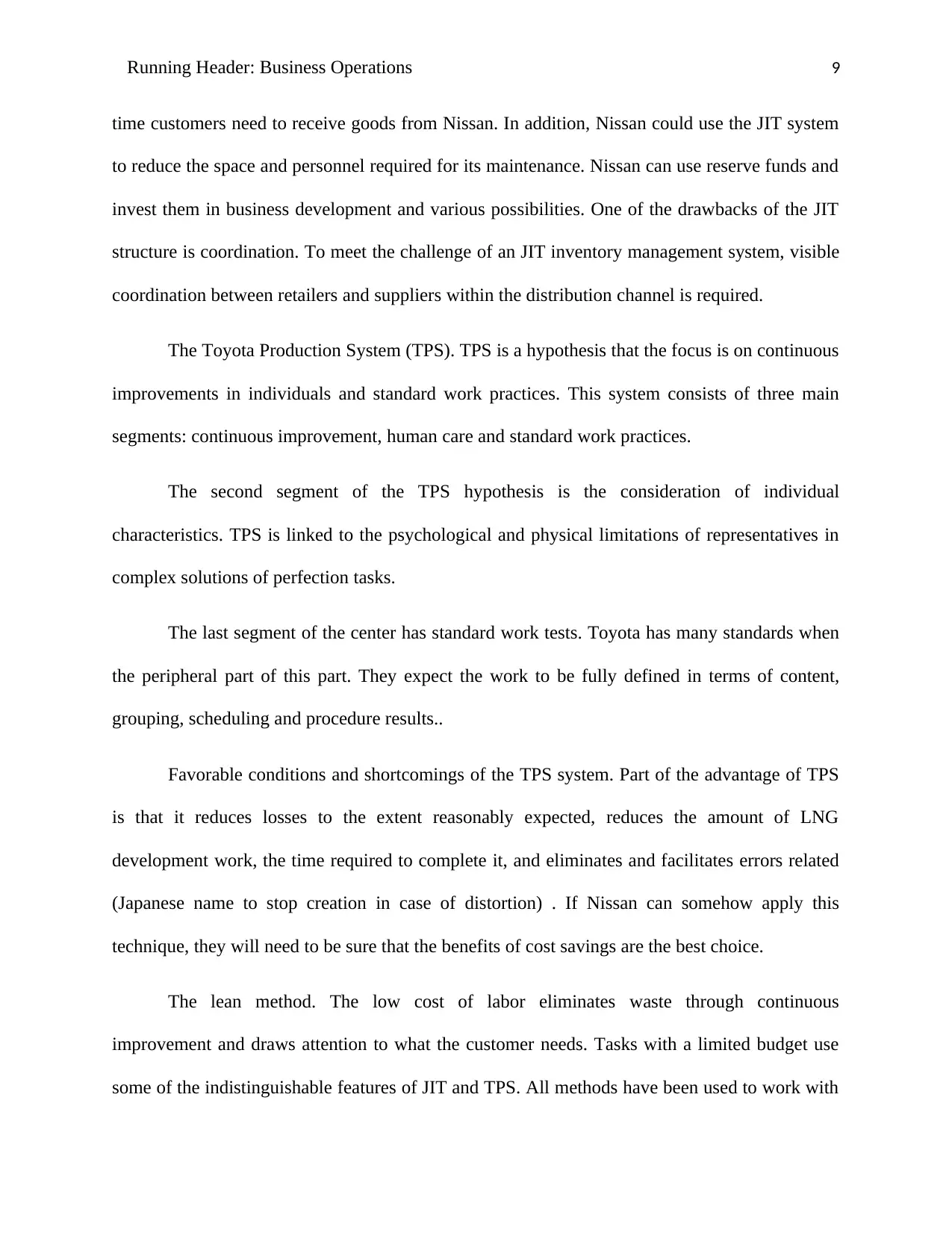
Running Header: Business Operations 9
time customers need to receive goods from Nissan. In addition, Nissan could use the JIT system
to reduce the space and personnel required for its maintenance. Nissan can use reserve funds and
invest them in business development and various possibilities. One of the drawbacks of the JIT
structure is coordination. To meet the challenge of an JIT inventory management system, visible
coordination between retailers and suppliers within the distribution channel is required.
The Toyota Production System (TPS). TPS is a hypothesis that the focus is on continuous
improvements in individuals and standard work practices. This system consists of three main
segments: continuous improvement, human care and standard work practices.
The second segment of the TPS hypothesis is the consideration of individual
characteristics. TPS is linked to the psychological and physical limitations of representatives in
complex solutions of perfection tasks.
The last segment of the center has standard work tests. Toyota has many standards when
the peripheral part of this part. They expect the work to be fully defined in terms of content,
grouping, scheduling and procedure results..
Favorable conditions and shortcomings of the TPS system. Part of the advantage of TPS
is that it reduces losses to the extent reasonably expected, reduces the amount of LNG
development work, the time required to complete it, and eliminates and facilitates errors related
(Japanese name to stop creation in case of distortion) . If Nissan can somehow apply this
technique, they will need to be sure that the benefits of cost savings are the best choice.
The lean method. The low cost of labor eliminates waste through continuous
improvement and draws attention to what the customer needs. Tasks with a limited budget use
some of the indistinguishable features of JIT and TPS. All methods have been used to work with
time customers need to receive goods from Nissan. In addition, Nissan could use the JIT system
to reduce the space and personnel required for its maintenance. Nissan can use reserve funds and
invest them in business development and various possibilities. One of the drawbacks of the JIT
structure is coordination. To meet the challenge of an JIT inventory management system, visible
coordination between retailers and suppliers within the distribution channel is required.
The Toyota Production System (TPS). TPS is a hypothesis that the focus is on continuous
improvements in individuals and standard work practices. This system consists of three main
segments: continuous improvement, human care and standard work practices.
The second segment of the TPS hypothesis is the consideration of individual
characteristics. TPS is linked to the psychological and physical limitations of representatives in
complex solutions of perfection tasks.
The last segment of the center has standard work tests. Toyota has many standards when
the peripheral part of this part. They expect the work to be fully defined in terms of content,
grouping, scheduling and procedure results..
Favorable conditions and shortcomings of the TPS system. Part of the advantage of TPS
is that it reduces losses to the extent reasonably expected, reduces the amount of LNG
development work, the time required to complete it, and eliminates and facilitates errors related
(Japanese name to stop creation in case of distortion) . If Nissan can somehow apply this
technique, they will need to be sure that the benefits of cost savings are the best choice.
The lean method. The low cost of labor eliminates waste through continuous
improvement and draws attention to what the customer needs. Tasks with a limited budget use
some of the indistinguishable features of JIT and TPS. All methods have been used to work with
⊘ This is a preview!⊘
Do you want full access?
Subscribe today to unlock all pages.

Trusted by 1+ million students worldwide
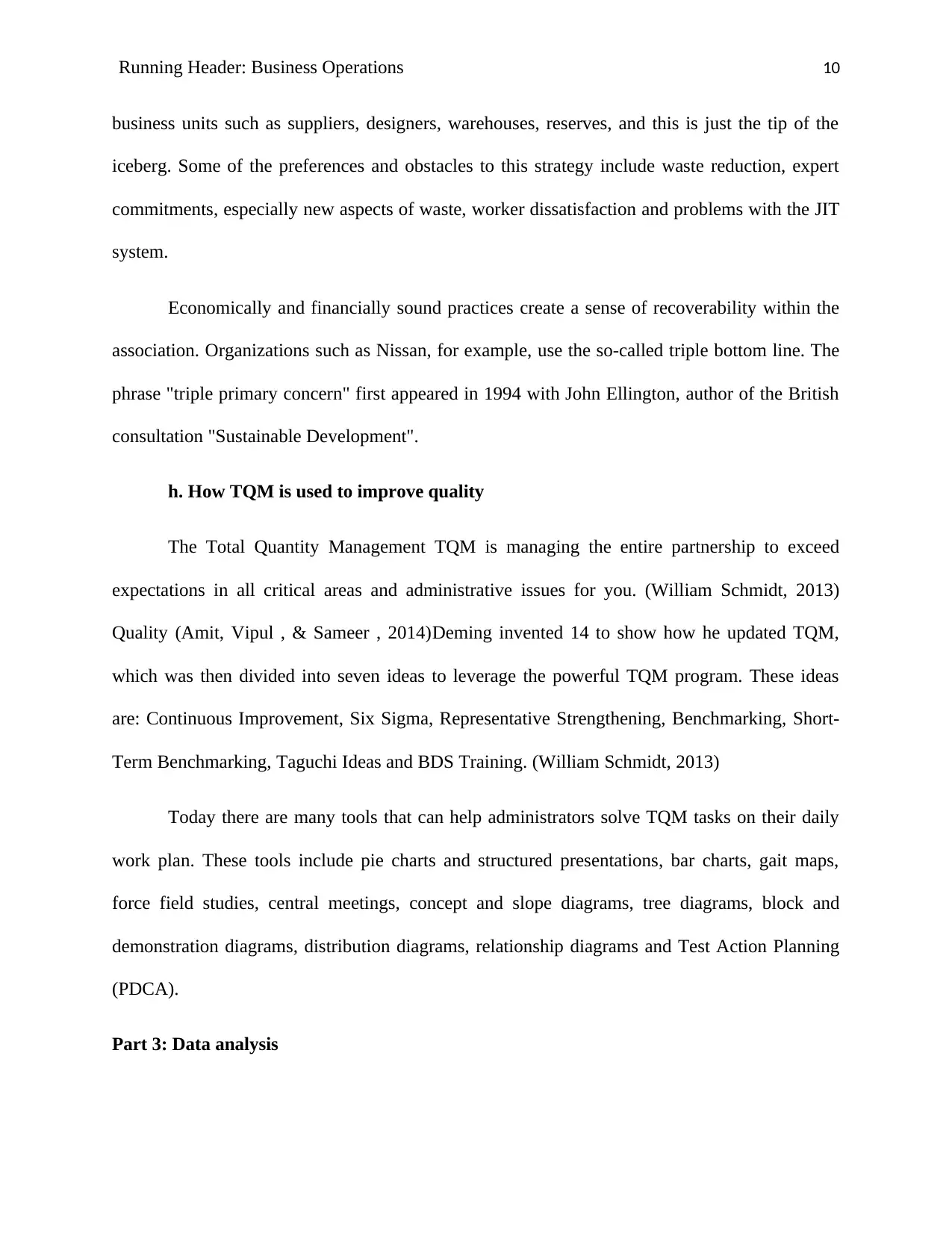
Running Header: Business Operations 10
business units such as suppliers, designers, warehouses, reserves, and this is just the tip of the
iceberg. Some of the preferences and obstacles to this strategy include waste reduction, expert
commitments, especially new aspects of waste, worker dissatisfaction and problems with the JIT
system.
Economically and financially sound practices create a sense of recoverability within the
association. Organizations such as Nissan, for example, use the so-called triple bottom line. The
phrase "triple primary concern" first appeared in 1994 with John Ellington, author of the British
consultation "Sustainable Development".
h. How TQM is used to improve quality
The Total Quantity Management TQM is managing the entire partnership to exceed
expectations in all critical areas and administrative issues for you. (William Schmidt, 2013)
Quality (Amit, Vipul , & Sameer , 2014)Deming invented 14 to show how he updated TQM,
which was then divided into seven ideas to leverage the powerful TQM program. These ideas
are: Continuous Improvement, Six Sigma, Representative Strengthening, Benchmarking, Short-
Term Benchmarking, Taguchi Ideas and BDS Training. (William Schmidt, 2013)
Today there are many tools that can help administrators solve TQM tasks on their daily
work plan. These tools include pie charts and structured presentations, bar charts, gait maps,
force field studies, central meetings, concept and slope diagrams, tree diagrams, block and
demonstration diagrams, distribution diagrams, relationship diagrams and Test Action Planning
(PDCA).
Part 3: Data analysis
business units such as suppliers, designers, warehouses, reserves, and this is just the tip of the
iceberg. Some of the preferences and obstacles to this strategy include waste reduction, expert
commitments, especially new aspects of waste, worker dissatisfaction and problems with the JIT
system.
Economically and financially sound practices create a sense of recoverability within the
association. Organizations such as Nissan, for example, use the so-called triple bottom line. The
phrase "triple primary concern" first appeared in 1994 with John Ellington, author of the British
consultation "Sustainable Development".
h. How TQM is used to improve quality
The Total Quantity Management TQM is managing the entire partnership to exceed
expectations in all critical areas and administrative issues for you. (William Schmidt, 2013)
Quality (Amit, Vipul , & Sameer , 2014)Deming invented 14 to show how he updated TQM,
which was then divided into seven ideas to leverage the powerful TQM program. These ideas
are: Continuous Improvement, Six Sigma, Representative Strengthening, Benchmarking, Short-
Term Benchmarking, Taguchi Ideas and BDS Training. (William Schmidt, 2013)
Today there are many tools that can help administrators solve TQM tasks on their daily
work plan. These tools include pie charts and structured presentations, bar charts, gait maps,
force field studies, central meetings, concept and slope diagrams, tree diagrams, block and
demonstration diagrams, distribution diagrams, relationship diagrams and Test Action Planning
(PDCA).
Part 3: Data analysis
Paraphrase This Document
Need a fresh take? Get an instant paraphrase of this document with our AI Paraphraser
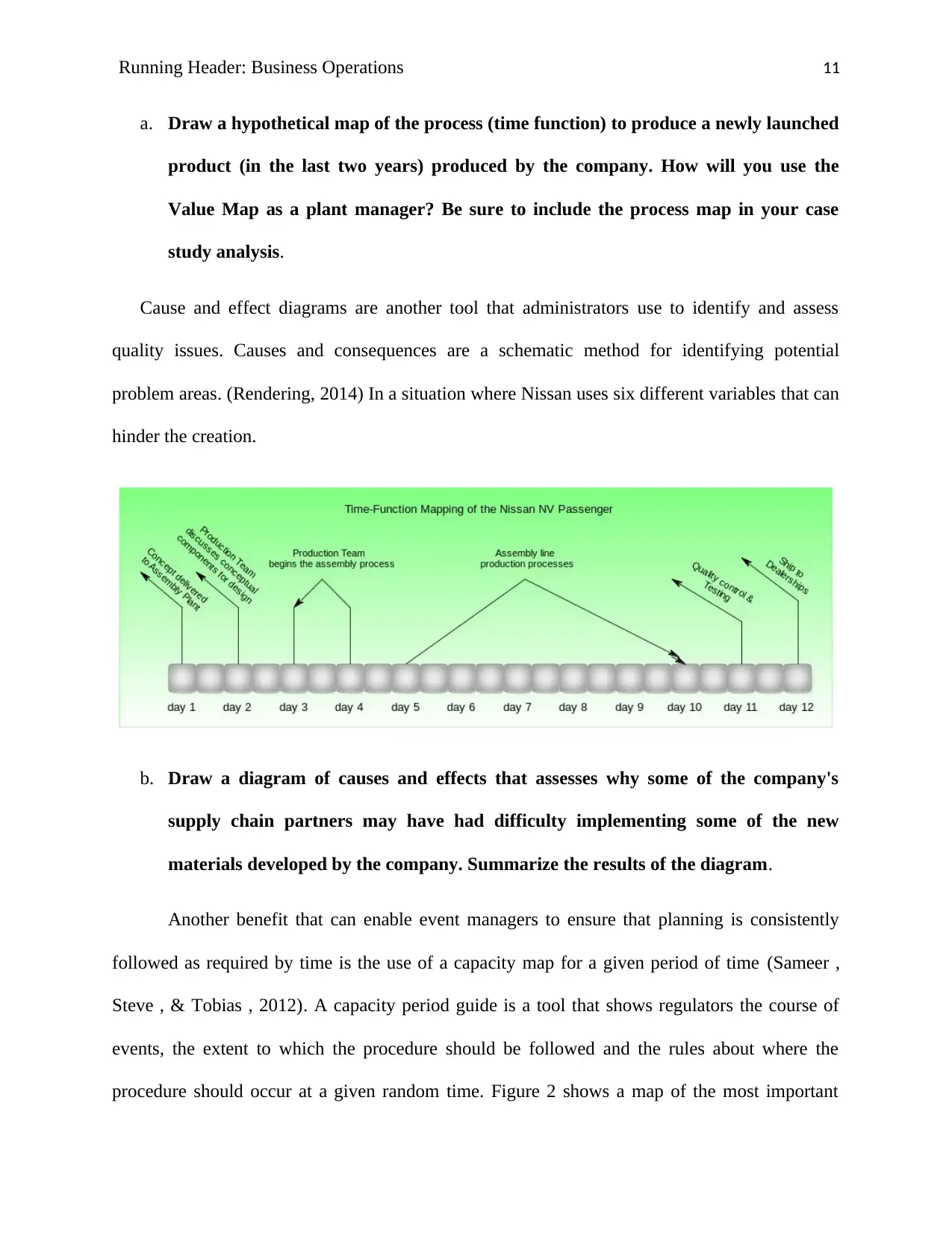
Running Header: Business Operations 11
a. Draw a hypothetical map of the process (time function) to produce a newly launched
product (in the last two years) produced by the company. How will you use the
Value Map as a plant manager? Be sure to include the process map in your case
study analysis.
Cause and effect diagrams are another tool that administrators use to identify and assess
quality issues. Causes and consequences are a schematic method for identifying potential
problem areas. (Rendering, 2014) In a situation where Nissan uses six different variables that can
hinder the creation.
b. Draw a diagram of causes and effects that assesses why some of the company's
supply chain partners may have had difficulty implementing some of the new
materials developed by the company. Summarize the results of the diagram.
Another benefit that can enable event managers to ensure that planning is consistently
followed as required by time is the use of a capacity map for a given period of time (Sameer ,
Steve , & Tobias , 2012). A capacity period guide is a tool that shows regulators the course of
events, the extent to which the procedure should be followed and the rules about where the
procedure should occur at a given random time. Figure 2 shows a map of the most important
a. Draw a hypothetical map of the process (time function) to produce a newly launched
product (in the last two years) produced by the company. How will you use the
Value Map as a plant manager? Be sure to include the process map in your case
study analysis.
Cause and effect diagrams are another tool that administrators use to identify and assess
quality issues. Causes and consequences are a schematic method for identifying potential
problem areas. (Rendering, 2014) In a situation where Nissan uses six different variables that can
hinder the creation.
b. Draw a diagram of causes and effects that assesses why some of the company's
supply chain partners may have had difficulty implementing some of the new
materials developed by the company. Summarize the results of the diagram.
Another benefit that can enable event managers to ensure that planning is consistently
followed as required by time is the use of a capacity map for a given period of time (Sameer ,
Steve , & Tobias , 2012). A capacity period guide is a tool that shows regulators the course of
events, the extent to which the procedure should be followed and the rules about where the
procedure should occur at a given random time. Figure 2 shows a map of the most important
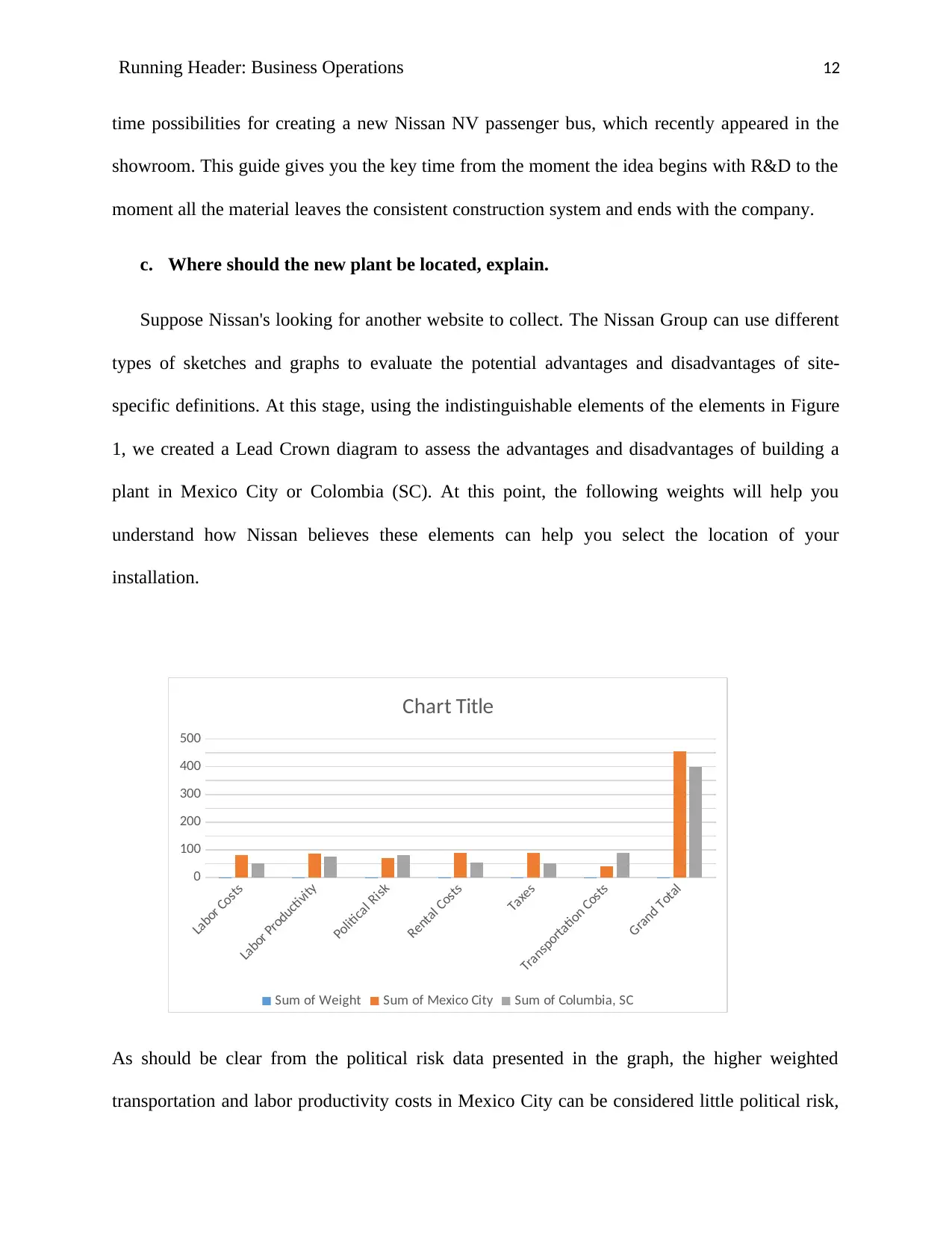
Running Header: Business Operations 12
time possibilities for creating a new Nissan NV passenger bus, which recently appeared in the
showroom. This guide gives you the key time from the moment the idea begins with R&D to the
moment all the material leaves the consistent construction system and ends with the company.
c. Where should the new plant be located, explain.
Suppose Nissan's looking for another website to collect. The Nissan Group can use different
types of sketches and graphs to evaluate the potential advantages and disadvantages of site-
specific definitions. At this stage, using the indistinguishable elements of the elements in Figure
1, we created a Lead Crown diagram to assess the advantages and disadvantages of building a
plant in Mexico City or Colombia (SC). At this point, the following weights will help you
understand how Nissan believes these elements can help you select the location of your
installation.
Labor Costs
Labor Productivity
Political Risk
Rental Costs
Taxes
Transportation Costs
Grand Total
0
100
200
300
400
500
Chart Title
Sum of Weight Sum of Mexico City Sum of Columbia, SC
As should be clear from the political risk data presented in the graph, the higher weighted
transportation and labor productivity costs in Mexico City can be considered little political risk,
time possibilities for creating a new Nissan NV passenger bus, which recently appeared in the
showroom. This guide gives you the key time from the moment the idea begins with R&D to the
moment all the material leaves the consistent construction system and ends with the company.
c. Where should the new plant be located, explain.
Suppose Nissan's looking for another website to collect. The Nissan Group can use different
types of sketches and graphs to evaluate the potential advantages and disadvantages of site-
specific definitions. At this stage, using the indistinguishable elements of the elements in Figure
1, we created a Lead Crown diagram to assess the advantages and disadvantages of building a
plant in Mexico City or Colombia (SC). At this point, the following weights will help you
understand how Nissan believes these elements can help you select the location of your
installation.
Labor Costs
Labor Productivity
Political Risk
Rental Costs
Taxes
Transportation Costs
Grand Total
0
100
200
300
400
500
Chart Title
Sum of Weight Sum of Mexico City Sum of Columbia, SC
As should be clear from the political risk data presented in the graph, the higher weighted
transportation and labor productivity costs in Mexico City can be considered little political risk,
⊘ This is a preview!⊘
Do you want full access?
Subscribe today to unlock all pages.

Trusted by 1+ million students worldwide
1 out of 18
Related Documents
Your All-in-One AI-Powered Toolkit for Academic Success.
+13062052269
info@desklib.com
Available 24*7 on WhatsApp / Email
![[object Object]](/_next/static/media/star-bottom.7253800d.svg)
Unlock your academic potential
Copyright © 2020–2025 A2Z Services. All Rights Reserved. Developed and managed by ZUCOL.





